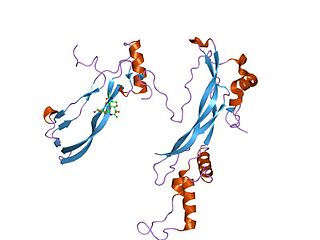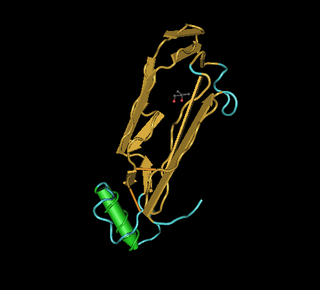
Fibrodysplasia ossificans progressiva, also called Münchmeyer disease or myositis ossificans progressiva, is an extremely rare connective tissue disease in which fibrous connective tissue such as muscle, tendons, and ligaments turn into bone tissue. It is the only known medical condition where one organ system changes into another. It is a severe, disabling disorder with no current cure or treatment.
Bone morphogenetic proteins (BMPs) are a group of growth factors also known as cytokines and as metabologens. Originally discovered by their ability to induce the formation of bone and cartilage, BMPs are now considered to constitute a group of pivotal morphogenetic signals, orchestrating tissue architecture throughout the body. The important functioning of BMP signals in physiology is emphasized by the multitude of roles for dysregulated BMP signalling in pathological processes. Cancerous disease often involves misregulation of the BMP signalling system. Absence of BMP signalling is, for instance, an important factor in the progression of colon cancer, and conversely, overactivation of BMP signalling following reflux-induced esophagitis provokes Barrett's esophagus and is thus instrumental in the development of esophageal adenocarcinoma.

Growth/differentiation factor 9 is a protein that in humans is encoded by the GDF9 gene.

Bone morphogenetic protein 7 or BMP7 is a protein that in humans is encoded by the BMP7 gene.

Bone morphogenetic protein 2 or BMP-2 belongs to the TGF-β superfamily of proteins.

Bone morphogenetic protein 4 is a protein that in humans is encoded by BMP4 gene. BMP4 is found on chromosome 14q22-q23.

Bone morphogenetic protein 10 (BMP10) is a protein that in humans is encoded by the BMP10 gene.

Bone morphogenetic protein 6 is a protein that in humans is encoded by the BMP6 gene.

Bone morphogenetic protein 5 is a protein that in humans is encoded by the BMP5 gene.

Bone morphogenetic protein 3, also known as osteogenin, is a protein in humans that is encoded by the BMP3 gene.
The transforming growth factor beta (TGFB) signaling pathway is involved in many cellular processes in both the adult organism and the developing embryo including cell growth, cell differentiation, cell migration, apoptosis, cellular homeostasis and other cellular functions. The TGFB signaling pathways are conserved. In spite of the wide range of cellular processes that the TGFβ signaling pathway regulates, the process is relatively simple. TGFβ superfamily ligands bind to a type II receptor, which recruits and phosphorylates a type I receptor. The type I receptor then phosphorylates receptor-regulated SMADs (R-SMADs) which can now bind the coSMAD SMAD4. R-SMAD/coSMAD complexes accumulate in the nucleus where they act as transcription factors and participate in the regulation of target gene expression.

Bone morphogenetic protein receptor type II or BMPR2 is a serine/threonine receptor kinase. It binds Bone morphogenetic proteins, members of the TGF beta superfamily of ligands, which are involved in paracrine signalling. BMPs are involved in a host of cellular functions including osteogenesis, cell growth and cell differentiation. Signaling in the BMP pathway begins with the binding of a BMP to the type II receptor. This causes the recruitment of a BMP type I receptor, which it phosphorylates. The Type I receptor phosphorylates an R-SMAD a transcriptional regulator.

The bone morphogenetic protein receptor, type IA also known as BMPR1A is a protein which in humans is encoded by the BMPR1A gene. BMPR1A has also been designated as CD292.

Activin receptor type-1B is a protein that in humans is encoded by the ACVR1B gene.

Activin A receptor, type I (ACVR1) is a protein which in humans is encoded by the ACVR1 gene; also known as ALK-2. ACVR1 has been linked to the 2q23-24 region of the genome. This protein is important in the bone morphogenic protein (BMP) pathway which is responsible for the development and repair of the skeletal system. While knock-out models with this gene are in progress, the ACVR1 gene has been connected to fibrodysplasia ossificans progressiva, a disease characterized by the formation of heterotopic bone throughout the body. It is a bone morphogenetic protein receptor, type 1.
Bone morphogenetic protein receptors are serine-threonine kinase receptors. Transforming growth factor beta family proteins bind to these receptors. There are four bone morphogenetic protein receptors:

Endoglin (ENG) is a type I membrane glycoprotein located on cell surfaces and is part of the TGF beta receptor complex. It is also commonly referred to as CD105, END, FLJ41744, HHT1, ORW and ORW1. It has a crucial role in angiogenesis, therefore, making it an important protein for tumor growth, survival and metastasis of cancer cells to other locations in the body.
Growth differentiation factors (GDFs) are a subfamily of proteins belonging to the transforming growth factor beta superfamily that have functions predominantly in development.

Growth differentiation factor 2 (GDF2) also known as bone morphogenetic protein (BMP)-9 is a protein that in humans is encoded by the GDF2 gene. GDF2 belongs to the transforming growth factor beta superfamily.
The transforming growth factor beta (TGFβ) receptors are a family of serine/threonine kinase receptors involved in TGF beta signaling pathway. These receptors bind growth factor and cytokine signaling proteins in the TGF-beta family such as TGFβs, bone morphogenetic proteins (BMPs), growth differentiation factors (GDFs), activin and inhibin, myostatin, anti-Müllerian hormone (AMH), and NODAL.














